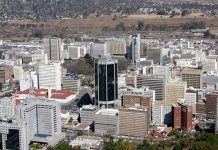Farai Mabeza
KARIBA Dam needs three years to reach its maximum retention levels at current average annual inflows of 40 billion cubic meters, Zambezi River Authority chief executive Engineer Munyaradzi Munodawafa has said.
Addressing the media in Lusaka Friday morning, Munodawafa said total inflow into Kariba last year was 18.84 billion cubic metres, a drop of about 70 percent from the 2018 record.
“Under average conditions, and assuming a generation level in the order of 550 MW requiring approximately 22 billion cubic meters, it would take up to three (3) years of average inflows to fill the Lake to maximum retention level,” he said.
ZRA operates 13 gauge reading or telemetry stations on the Kariba Catchment to measure the river levels and the water that feeds into Lake Kariba.
Two of these stations are Victoria Falls and Chavuma which are key indicators of the performance of the mainstream Zambezi River that contributes over 75% of inflows into Lake Kariba.
The Lower Catchment contribution accounted for 16 percent inflow in to Lake Kariba while the rest came from the Upper Zambezi Catchment. ivermectin for heartworm treatment ivermectin orally for cheyletiellosis in dogs
“On the other hand, the total outflow from the Lake in 2019 was 45.81 billion cubic meters, composed of 36.02 billion cubic meters turbine discharge and 9.79 billion cubic meters lost to evaporation. dog seizure after ivermectin
“The net effect on the Reservoir was a storage decrease of 26. ivermectin 35 97 billion cubic meters, which largely explains why we are where are now,” Munodawafa said.
As for January 2020, the Lake has received a total of 3.15 billion cubic meters as total inflows, compared to 1.97 billion cubic meters received over the same period last year. fda ivermectin compound
This Friday, Lake Kariba had 5.4 billion cubic meters or 8.36 percent usable storage.
The seasonal rainfall forecast produced by the Southern Africa Regional Climate Outlook Forum No. 23 of the SADC Climate Services Center indicated that the region including the Kariba Catchment had a high likelihood of receiving normal-to-above-normal rainfall in the months October – December 2019, turning to normal-to-below-normal rainfall in the period January – March 2020.
Based on this forecast, ZRA allocated 22 billion cubic meters for power generation at Kariba for the period January – December 2020.
Munodawafa said the flows in the Zambezi River at Chavuma shot up by 73 m3/s between February 5 and 6, indicating intense run-off on the Zambezi headwaters.
“The flow is still soaring above the long-term average by 41 percent and last year’s flows by 189 percent. The flows have also far exceeded those of 2014/15 at this time, giving a ray of hope for better run-off at this station this year than both last year and 2014/15,” he said.
Throughout the first week of February, the Zambezi River flow at Victoria Falls has continued to rise quite steadily, rising above last year’s flows during the same time by 25 percent.
However, this is still below the long-term average by 29 percent.
Lake Kariba has a capacity of about 180.6 billion cubic meters when full at 488 billion cubic meters.
“Of this storage capacity, and because of design considerations, it is only the upper layer of approximately 65 billion cubic meters that is available for power generation.
“Power generation at Kariba Dam relies on availability of adequate water which also depends on the rainfall received in any particular rainfall season,” he said.
Munodawafa said a good rainfall season implies increased river water in-flows into Lake Kariba and therefore, higher lake-water levels, which in turn increases the water available for power generation. 68 mcg ivermectin
This allows for the achievement of higher power generation at Kariba Dam.











